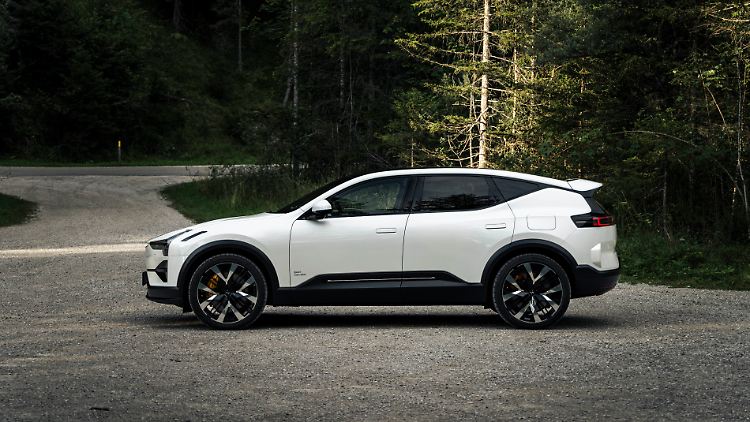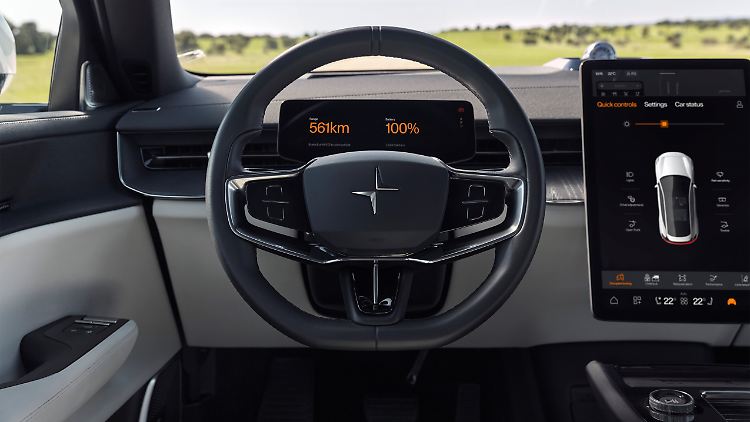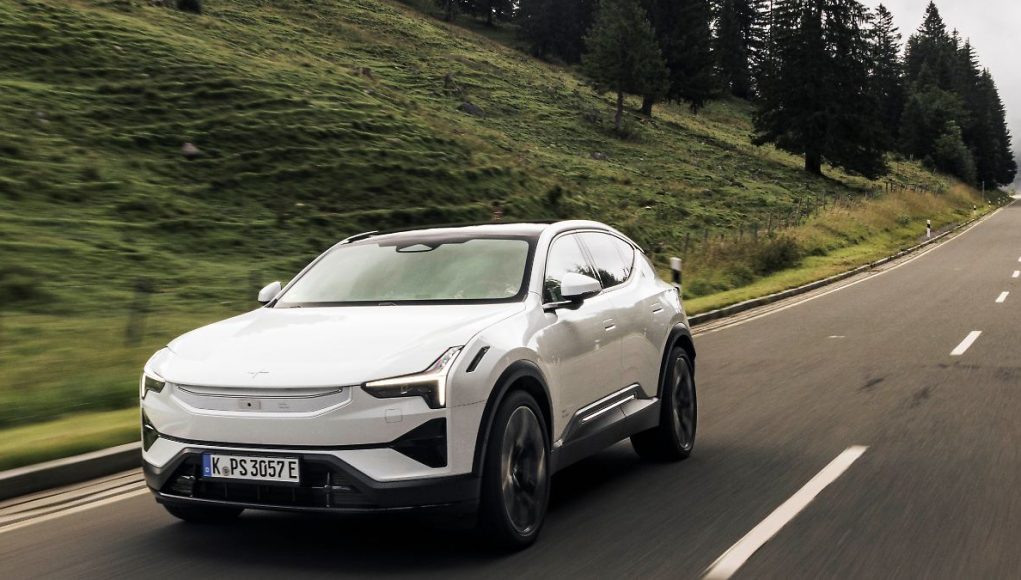Stately SUV in the driving report
Polestar 3 – the three-seater should fix it
This audio version was artificially generated. More info | Send feedback
The manufacturer's expectations for the Polestar 3 are high. Together with the Polestar 4, which will be launched almost at the same time, it is expected to put the Chinese-Swedish brand in the fast lane. But does it actually have what it takes?
With the Polestar 2, the Geely and Volvo subsidiary Polestar has made a good start in Germany compared to other Chinese brands and has achieved a respectable success. The breakthrough is now to be achieved by the numbers three and four, which have just been launched in Europe slightly later due to various delays. Is the 3 Series, which costs just under 80,000 euros, suitable as a game changer?


The Polestar 3 is still based on Volvo's SPA-2 platform, which was developed for combustion engines.
(Photo: Polestar)
The design of the 4.90 meter long newcomer from the luxury segment is a positive feature. The Polestar 3 continues the design language of the 2 Series, focusing on good aerodynamics and a confident appearance. There's no question: Polestar can also do SUVs. In contrast to the SUV coupe Polestar 4, the 3 is still based on Volvo's Scalable Product Architecture (SPA 2), which was originally developed for combustion engines. It carries a 111 kWh battery in the frame, which according to the WLTP standard should enable ranges of between 561 and 650 kilometers.
Available in three versions


Objective: the rear of the Polestar 3 with a continuous light bar and a coupé-like roof finish.
(Photo: Polestar)
The Polestar 3 is available in three versions with 220 kW/299 hp and rear-wheel drive and with 360 kW/489 hp or 380 kW/517 hp with all-wheel drive. The latter is made possible by one motor at the front and one at the rear. The rear motor can be decoupled and put to rest under certain conditions for efficiency reasons. There is also an electric torque vectoring dual clutch function on the rear axle, which is intended to improve cornering dynamics.
There was definitely nothing to criticize during test drives on Upper Bavarian country roads. The Polestar 3 can very cleverly conceal its more than two and a half tons and its overall imposing shape, also thanks to the standard two-chamber air suspension. Only in very tight, very fast corners do you feel the sheer mass of the sister model of the also fully electric Volvo EX90. The chassis and steering can be adjusted to individual taste, as can the intensity of the recuperation. However, this is not done with paddles on the steering wheel as is usually the case, but via an ever-present virtual button on the display.
Starting from traffic lights or merging at intersections can be done quickly. The version with one motor manages the sprint from 0 to 100 km/h in 7.8 seconds, the version with two motors in 5.0 and 4.7 seconds respectively. The speed is limited to 180 and 210 km/h respectively. And in the ideal case, 650 (single motor), 631 (dual motor) or 561 kilometers (performance package) can be covered on one battery charge. Charging is done on the fast charger with up to 250 kW, which is very good for a 400-volt system and allows the battery to be charged from 10 to 80 percent in just half an hour. The performance when charging with alternating current is less praiseworthy. The Polestar 3 only manages eleven kW and needs eleven hours to go from 0 to 100 percent. Other electric vehicles can do this better.
Scandinavian clarity with a touch of elegance


The front shows the Scandinavian design line of the Polestar 3 best.
(Photo: Polestar)
The interior of the new addition, produced in China and the USA, exudes Scandinavian clarity and a touch of elegance. The covers and trim were selected based on sustainability features and fit well into the somewhat matter-of-fact, cool overall concept. The operation via the 14.5-inch display in portrait format and a few steering wheel buttons is not necessarily self-explanatory, but compared to more complicated competitors, it is relatively easy to internalize. As in the Polestar 2, the Android Automotive operating system, developed together with Google, is used here, supported by fixed computers, and left a very positive impression during our test drives.


Factual and informative: the displays in the Scandinavian-Asian Polestar 3.
(Photo: Polestar)
In order to meet Scandinavian safety standards, the Polestar 3 uses a veritable armada of five radar modules, five external cameras and twelve ultrasonic sensors. In the interior, eye-tracking technology is used to check the driving ability of the person behind the wheel – if necessary, the system even brakes the car to a standstill. In addition, radar cameras in the interior check whether children or dogs have been accidentally left behind in the interior, and the connection to the air conditioning system is intended to prevent heat stroke or hypothermia.
Lots of space, especially in the front


Under the flap at the front, a frunk offers space for charging cables and other small items.
(Photo: Polestar)
There is plenty of space in the Chinese-Swedish SUV, especially in the first row. The slight coupé line of the roof does not change the decent headroom in the back, although this is achieved by the relatively low rear seat. Long-legged people will therefore lack thigh support. The trunk volume is between 481 and 1411 liters, and there is additional space under the cover and in the frunk under the front hood.
The Polestar 3 is a pleasant experience to drive. Despite its size, it is not too bulky in traffic and can be maneuvered easily and precisely. The warnings from the assistance systems can be switched off quite easily. However, you should always leave the speed limit activated, especially in the performance version. This is because the respective limit is usually exceeded with just one step on the accelerator pedal.
From a technical and visual perspective, the Polestar 3 certainly has what it takes to pave the way to profitability for the Euro-Asian brand. However, there are also various competitors from established brands. And entry-level prices of 78,590 to 92,190 euros are unlikely to be conducive to high volumes, despite a 4,000 euro discount that runs until November.
Technical data – Polestar 3 Long Range Dual Motor with Performance Package
- Five-door, five-seat mid-size SUV
- Length: 4.90 meters, width: 1.94 meters (with exterior mirrors 2.12 meters), height: 1.61 meters, wheelbase 2.99 meters, trunk volume: 484-1411 liters, front storage compartment (frunk): 32 liters
- Two electric motors, 380 kW/517 hp, maximum torque 910 Nm, battery with 111 kWh, range according to WLTP: 561 km, one-speed automatic, all-wheel drive
- Vmax 210 km/h, 0-100 km/h: 4.7 s, charging power: DC up to 250 kW (30 min from 10-80 percent, AC up to 11 kW (11 hrs.), WLTP standard consumption: 22.1-23.0 kWh/100 km
- Price: from 92,190 euros































